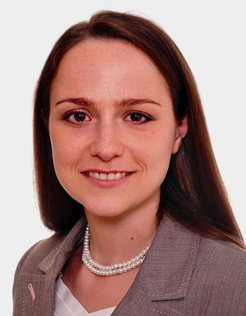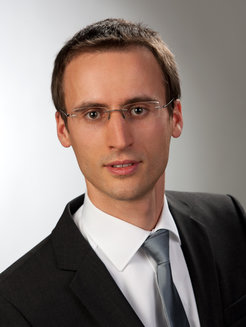The Max Planck Institute of Quantum Optics wins "Otto-Hahn-Triple"
Elisabeth Bothschafter, Andreas Reiserer, and Michael Krüger are excelled with the Otto Hahn Medal by the Max Planck Society.
This year, the Max Planck Society has awarded the Otto Hahn Medal 2014 to three young scientists who have completed their doctoral thesis at the Max Planck Institute of Quantum Optics: Elisabeth Bothschafter, Andreas Reiserer, and Michael Krüger. Since 1978 the Max Planck Society has presented this honour annually to around 30 junior scientists for ground-breaking scientific achievements connected to their doctoral thesis. The award is intended to encourage highly talented people to decide for a career in fundamental research. In addition, Andreas Reiserer is going to receive the Otto Hahn Award that each section of the MPG annually donates to one scientist only.
Dr. Elisabeth Bothschafter receives the Otto Hahn Medal for “Investigations of the non-linear interaction of light and matter in dielectric materials on the attosecond time-scale”.

Elisabeth Bothschafter studied physics at the University of Stuttgart and engineering at the Ecole Centrale Paris in the framework of a double diploma program which she completed in 2009. Her diploma thesis was carried out in the Attosecond Physics Division of Prof. Ferenc Krausz at the MPQ. In 2010 she became a member of the International Max Planck Research School of Advanced Photon Science (IMPRS-APS) and continued as a doctoral student in the same division. From 2012 to 2014 Elisabeth Bothschafter was Vice-President of the Student Chapter Munich of the Optical Society of America (OSA). In May 2014 she completed her thesis “Femtosecond and Attosecond Electron Dynamics in Semiconductors and Dielectrics” under the supervision of Prof. Reinhard Kienberger and received her doctoral degree from the Technische Universität München.
Elisabeth Bothschafter investigated the interaction of femtosecond light-pulses with electrons bound in silicon-dioxide whereby she discovered entirely new processes: she was able to demonstrate that – even at very high fields – the material would almost instantaneously react to the oscillations of light waves, but return to its former state after the laser pulse had passed. This result is of high importance concerning possible technical applications, for example optical transistors. Now she has a postdoc position in the group of Dr. Urs Staub at the “Swiss Light Source” at the Paul-Scherrer-Institut (Villigen, Switzerland).
Dr. Andreas Reiserer is awarded the Otto Hahn Medal for the “Nondestructive detection of an optical photon and the realization of a quantum gate between an atom and a photon”.

Andreas Reiserer studied physics at the University of Würzburg where he received his “Master of Science” in 2009. During that time he had a stipend of the “Studienstiftung des Deutschen Volkes”. His doctoral thesis made him come to Garching (near Munich) where he became a member of the Quantum Dynamics Division of Prof. Gerhard Rempe at MPQ.
In his doctoral thesis “A controlled phase gate between a single atom and an optical photon” he was working on several groundbreaking experiments in the field of quantum information science. Here, a single atom trapped inside a high-finesse optical cavity detects a single optical photon without destroying it. Using the photon as a “flying” quantum bit and the atom as a “stationary” one Andreas Reiserer was able to realize a quantum logic gate between light and matter. These experiments are of fundamental importance for the implementation of a future quantum internet.
Having received his doctoral degree at the Technische Universität München in 2014, Andreas Reiserer became a postdoctoral researcher in the “Quantum Transport” group of Prof. Dr. Ronald Hanson, Kavli Institute of Nanoscience and Technical University of Delft (Netherlands). The young scientist will also receive the Otto Hahn Award which implies the opportunity to become leader of a research group at a Max Planck Institute after having stayed abroad.
Nominated by the Max Planck Institute for the Science of Light, Dr. Michael Krüger receives the Otto Hahn Medal for “Investigations of ultrafast electronic processes on nanostructures with phase-controlled laser pulses”.

Michael Krüger studied physics at the Ludwig-Maximilians-Universität München where he received his diploma in 2009. Both his diploma thesis and his doctoral thesis were carried out in the research group “Ultrafast Quantum Optics” of Dr. Peter Hommelhoff at the MPQ.
In his thesis “Attosecond physics in strong-field photoemission from metal nanotips”, Michael Krüger observed pivotal processes of attosecond and strong-field science in solids. In the optical field of an intense laser pulse an electron is first driven away from its parent atom, but eventually returns to it within an optical half cycle. At the point of recollision, the energy the electron had gained can be radiated away, or the electron can just scatter elastically. The occurring of the latter process at a metal nano-tip has been demonstrated for the first time by Michael Krüger. That way the young scientist proved that the electrical field of the laser pulses allows controlling electrons at a nanoscale solid state system. This opens the door to extremely fast light-controlled electronics.
Having received his doctoral degree from the Ludwig-Maximilians-Universität München in October 2013, Michael Krüger followed his advisor Peter Hommelhoff, who had accepted a professorship at the Universität Erlangen-Nürnberg in 2012. Since June 2014 he has been a postdoctoral researcher in the group of Prof. Nirit Dudovich at the Weizmann Institute of Science in Rehovot, Israel. Last year he has received the Koshland Prize for outstanding postdoctoral fellows.
Elisabeth Bothschafter, Andreas Reiserer, and Michael Krüger will be presented with the Otto Hahn Medal – which is endowed with prize money of 7500 Euro – on the occasion of the General Meeting of the Max Planck Society in Berlin on June 17th, 2015. Olivia Meyer-Streng


